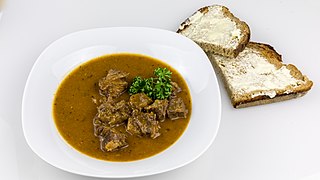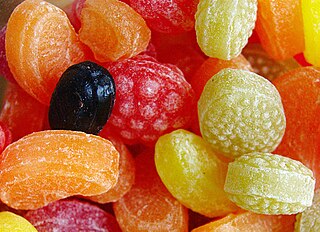
Confectionery is the art of making confections, which are food items that are rich in sugar and carbohydrates. Exact definitions are difficult. In general, however, confectionery is divided into two broad and somewhat overlapping categories: bakers' confections and sugar confections. The occupation of confectioner encompasses the categories of cooking performed by both the French patissier and the confiseur.

Ginger is a flowering plant whose rhizome, ginger root or ginger, is widely used as a spice and a folk medicine. It is a herbaceous perennial which grows annual pseudostems about one meter tall, bearing narrow leaf blades. The inflorescences bear flowers having pale yellow petals with purple edges, and arise directly from the rhizome on separate shoots.

Douhua is a Chinese sweet or savoury snack made with silken tofu. It is also referred to as doufuhua, tofu pudding, soybean pudding or, particularly in northern China, tofu brains.

Ginger beef is a Canadian Chinese dish made from beef, ginger, and a distinctive sweet sauce.

Filipino cuisine is composed of the cuisines of more than a hundred distinct ethnolinguistic groups found throughout the Philippine archipelago. A majority of mainstream Filipino dishes that compose Filipino cuisine are from the food traditions of various ethnolinguistic groups and tribes of the archipelago, including the Ilocano, Pangasinan, Kapampangan, Tagalog, Bicolano, Visayan, Chavacano and Maranao ethnolinguistic groups. The dishes associated with these groups evolved over the centuries from a largely indigenous base shared with maritime Southeast Asia with varied influences from Chinese, Spanish and American cuisines, in line with the major waves of influence that had enriched the cultures of the archipelago and adapted using indigenous ingredients to meet local preferences.

Ting is a carbonated beverage popular in the Caribbean. It is flavored with Jamaican grapefruit juice and is both tart and sweet. Ting comes in a green glass bottle, green plastic bottle or a green and yellow can. Like Orangina, the beverage contains a small amount of sediment consisting of grapefruit juice pulp. Ting is produced in the United Kingdom under license by Refresco Beverages. Ting also now makes Pink Ting Soda, Orange Ting, Diet Ting Soda, and ginger beer.

Sayur asem or sayur asam is an Indonesian vegetable soup. It is a popular Southeast Asian dish originating from Sundanese cuisine, consisting of vegetables in tamarind soup.

Alpinia officinarum, known as lesser galangal, is a plant in the ginger family, cultivated in Southeast Asia. It originated in China, where its name ultimately derives. It can grow 1.5 to 2 m high, with long leaves and reddish-white flowers. The rhizomes, known as galangal, are valued for their sweet spicy flavor and aromatic scent. These are used throughout Asia in curries and perfumes, and were previously used widely in Europe. They are also used as a herbal remedy.

Oxtail soup is a soup made with beef tails. The use of the word "ox" in this context is a legacy of nomenclature; no specialized stock of beef animals are used and tails may come from bovines other than oxen. It is believed by some that oxtail soup was invented in Spitalfields in London in the seventeenth century by French Huguenot and Flemish immigrants, from the tails of animals. Different versions of oxtail soup exist: Korean; Chinese; a fried/barbecued oxtail combined with soup variation which is a popular dish in Indonesia where it is called as sop buntut; an ethnic dish of the American South which traces its lineage back to the pre-revolutionary war era; and a thick, rich, gravy-like soup popular in the United Kingdom since the 18th century. Creole oxtail soup is made from a tomato base with oxtails, potatoes, green beans, corn, mirepoix, garlic, and herbs and spices.

Bandrek is a traditional hot, sweet and spicy beverage native to Sundanese of West Java, Indonesia. The Sundanese people who live in the cool, highlands consume bandrek to warm themselves at night and during cold weather.

Ginger tea is a herbal beverage that is made from ginger root. It has a long history as a traditional herbal medicine in East Asia, South Asia, Southeast Asia, and West Asia.

Sesame seed candy is a confection of sesame seeds and sugar or honey pressed into a bar or ball. It is popular from the Middle East through South Asia to East Asia. The texture may vary from chewy to crisp. It may also be called sesame (seed)candy/bar/crunch; sesame seed cake may refer to the confection or to a leavened cake or cookie incorporating sesame.

A hard candy, or boiled sweet, is a sugar candy prepared from one or more sugar-based syrups that is heated to a temperature of 160 °C (320 °F) to make candy. Among the many hard candy varieties are stick candy such as the candy cane, lollipops, rock, aniseed twists, and bêtises de Cambrai. "Boiled" is a misnomer, as sucrose melts fully at approximately 186 °C. Further heating breaks it into glucose and fructose molecules before it can vaporize.

Bajigur is a hot and sweet beverage native to the Sundanese people of West Java, Indonesia. The main ingredients are coconut milk and Aren sugar; usually to add taste, a small amount of ginger and a small pinch of salt. Traditionally fragrant pandan leaves were added, but now often artificial vanilla powder is used. It can also include kopi tubruk, finely pounded coffee.

Bumbu is the Indonesian word for a blend of spices and for pastes made from these blends, and it commonly appears in the names of spice mixtures, sauces and seasoning pastes. The official Indonesian language dictionary describes bumbu as "various types of herbs and plants that have a pleasant aroma and flavour — such as ginger, turmeric, galangal, nutmeg and pepper — used to enhance the flavour of the food."

Sambal is an Indonesian chilli sauce or paste, typically made from a mixture of a variety of chilli peppers with secondary ingredients such as shrimp paste, garlic, ginger, shallot, scallion, palm sugar, and lime juice. Sambal is an Indonesian loanword of Javanese origin. It originated from the culinary traditions of Indonesia and is also an integral part of the cuisines of Singapore, Malaysia, Brunei, and Sri Lanka. It has also spread through overseas Indonesian populations to the Netherlands and Suriname.

There have been more than 300 limited-edition seasonal and regional flavors of Kit Kat chocolate bars produced in Japan since 2000, many exclusive to the country and not produced elsewhere. Nestlé, which operates the Kit Kat brand in Japan, reports that the brand overtook Meiji Chocolate as the top-selling confectionery in Japan from 2012 to 2014. The company's marketing campaign, which partnered with Japan Post to sell the bar in 20,000 post offices, won an award in 2010. The campaign encouraged associations of the product's name with the coincidental cognate Kitto Katsu (きっと勝つ), translated as "You will surely win", and could be mailed as a good luck charm for students ahead of university exams.
Hard soda, also referred to as flavored beer, adult soda, fermented soda, mature soda and alcohol soda, is a type of alcoholic beverage and craft beer that is manufactured in the style of a soft drink. It has gained recent prominence in the United States after the success of the Not Your Father's Root Beer brand manufactured by Small Town Brewery. As of late May 2016, at least 39 hard soda brands exist in the United States.

















